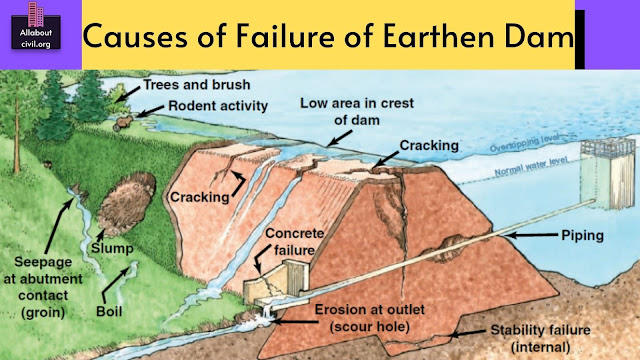 |
Various causes of failure of earth dams may be grouped under the following three categories:
1. Hydraulic failures
2. Seepage failures
3. Structural failures
Based on the investigations it has been found that about 35% of failures of dams are due to hydraulic failures, about 38% due to seepage failure, 20% under structural failure. Remaining 7% may be attributed to miscellaneous causes.
1. Hydraulic Failures
This type of failure include the following causes:
a. Overtopping – This is the most common type of failure of earth dams. The reasons may be underestimation of design flood, insufficient spillway capacity, insufficient free board, settlement of dam and foundation etc. Failure of dams due to overtopping is about 30%.
b. Erosion of upstream slope by waves – Usually the upstream slopes of the dams are provided with protective covering along with filter bed to protect the soil mass from wave action. If the protective covering is inadequate and filter bed is not properly graded, the covering as well as filter bed may be damaged by erosive action of waves produced on the surface of the water. As a result, the soil mass of the upstream slope gets eroded. This erosion of the upstream slope has caused about 5% of the failures of dams.
c. Erosion of downstream slope by wind and rain – Improper protection of downstream slope causes the erosion of the downstream slope due to wind and rain. The rainwater flowing down the slope may cause the formation of gullies on the downstream slope thus damaging the dam.
d. Erosion of the downstream toe – Downstream toe of the earth dam is eroded due to (i) presence of tail water (ii) cross currents produced from water discharging from spillway.
2. Seepage Failures
This failure include the following causes:
a. Piping through the body of the dam and its foundation –
Piping is the progressive backward erosion, which may be caused through an earth dam or its foundation by the seeping water. The piping usually results from leaks developed through the dam and foundation.
The common causes of the development of leaks are:
i) Poor control during construction.
ii) Differential settlement of the dam and foundation.
iii) Animal burrows.
iv) Surface drying cracks as well as shrinkage cracks.
v) Presence of roots and foreign materials.
Besides the horizontal piping, vertical piping may also occur at the downstream toe of an earth dam, which is called sand boil condition. Piping is one of the common causes of failure of earthen dams, which attributes to about 23% of failure.
b. Conduit leakage –
This may cause the failure of the earth dam in following two ways:
i) Seepage along the conduit wall – This occurs due to poorly compacted soil around the conduit or if there is a gap between the conduit and the surrounding soil mass. The seepage caused along the conduit wall may develop piping.
ii) Seepage through the cracks developed in the conduit – Due to unequal settlement of the dam and settlement of the soil below conduits the conduit may get cracked. It contributes to about 12% of total failure of earth dams and about 33% of seepage failure.
c. Sloughing–
It is the falling away of the soil mass of an earth dam. This occurs when the downstream portion of the dam becomes saturated and remains saturated continuously for long time. The soil mass on the downstream portion softens and gets eroded and produces a miniature slide. This causes the downstream slope to become steeper and unstable, leading to failure. This contributes to 2% of failure of earth dams in the past.
3. Structural Failures
This includes the failures of earth dams due to:
a. Sliding of upstream and downstream slopes –
About 15% of failure of dams in the past is due to this cause. The critical conditions during which the sliding of upstream and downstream slopes may be caused are:
i) Sliding of upstream slope during sudden drawdown.
ii) Sliding of downstream slope during steady seepage.
iii) Sliding of upstream and downstream slopes during construction
b. Flow slides due to spontaneous liquefaction – Sometimes large part of the soil mass is carried momentarily by the pore water of the saturated soil and very little inter-granular pressure exists within the soil mass so that the shear strength of the soil is reduced almost to that of the liquid and the soil mass flows downwards. This attributes to about 3% of the failure of dams in the past.
c. Damage caused by burrowing of animals – The animals like muskrats, ground squirrels dig holes in earth dams to make their homes. These become free passages of water from upstream to downstream face of the dam. However, failure of earth dams due to burrowing of animals is caused only in case of small dams.
d. Damage caused by water soluble materials – The leaching of water soluble materials such as gypsum, iron oxides etc., creates cavities and form flow channels causing settlement of dam.
e. Damage caused by earthquake –
Some of the damages caused due to earthquake are:
i) Longitudinal cracks at the top of the dam.
ii) Liquefaction of saturated soil at the lower portion of the dam.
iii) Settlement of crest of dam, thus reducing free board and increasing possibility of overtopping.
iv) Cracking of central core.
v) Shear failure at the base of the dam, etc.
Also Read : Earthen Dams-Types of earthen dams
